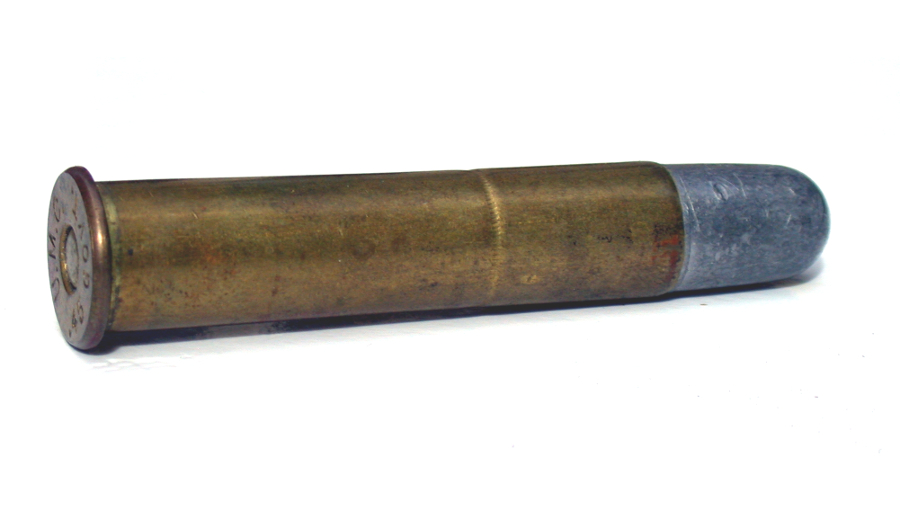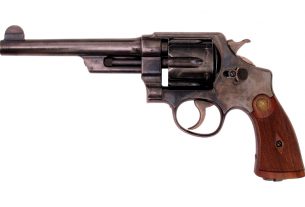Nearly 150 years after its introduction, the .45-70 cartridge is breathing new life as a favored hunting, competition, and defense cartridge. Originally developed in 1873 for use in the Springfield Model 1873 “Trapdoor” rifle, the .45-70 served as the standard US military service cartridge for almost 20 years, before being replaced by the .30-40 Krag in 1892.
The .45-70 in government service was provided in two versions. The first, the .45-70-405, featured a .45-caliber bullet weighing 405 grains, pushed by 70 grains of blackpowder. Muzzle velocity was around 1,400 feet per second, resulting in around 1,750 foot-pounds of muzzle energy.
Unimpressed by the rainbow trajectory of the round, the Army developed a .45-70-500 load, featuring a 500-grain bullets. Maximum range of that round was over 3,000 meters, nearly two miles. Tests at the Sandy Hook Proving Ground found that the 500-grain bullets could penetrate three one-inch thick boards at two miles, then penetrate an additional eight inches of sand.
With maximum accuracy on man-sized targets coming at 200-300 yards, the use of massed volley fire by infantry troops could still result in fatalities and casualties at extended ranges as a result of that volley fire. The necessity of maximum individual accuracy from an individual rifleman was still a ways away.
For a time it appeared that the .45-70 would go the way of many other blackpowder cartridges. Pushed to the side by more effective smokeless powder cartridges, the .45-70 seemed to be obsolete. But renewed interest in older cartridges and lever-action rifles in recent years has spurred renewed interest in the .45-70. And with advances in metallurgy since 1873, modern rifles are able to handle .45-70 loads that are far more powerful than those old-time loads.
Those looking to shoot or reload the .45-70 need to be aware that modern .45-70 ammunition is loaded to three different power levels. The first power level, topping out at about 28,000 pounds per square inch (PSI) of pressure, is for older rifles and trapdoor rifles. The second power level is for modern lever-action rifles such as the Marlin 1895, Henry, or modern Winchester 1886, and tops out at around 40,000 PSI. The final power level is for Ruger No. 1 and similar rifles, topping out at about 50,000 PSI.
Standard pressure .45-70 loads can feature a 300-grain bullet traveling at up to 2,100 feet per second, a 405-grain bullet traveling at up to 1,800 feet per second, or a 500-grain bullet traveling at up to 1,450 feet per second. Maximum muzzle energy is around 2,900 foot-pounds.
Loads for lever-action rifles can feature a 300-grain bullet traveling at up to 2,400 feet per second, a 405-grain bullet at up to 2,100 feet per second, and a 500-grain bullet at up to 1,700 feet per second. Muzzle energy maxes out at around 4,000 foot-pounds.
The highest-pressure 45-70 loads feature 500-grain loads at up to 1,800 feet per second, and some handloaders have even pushed 550-grain bullets up to 1,900 feet per second. Muzzle energy runs from 4,000 to 4,500 foot-pounds, rivaling dangerous game cartridges such as the .458 Winchester Magnum, .404 Jefferey, and .450 Nitro Express.
Ammunition for the .45-70 generally starts at about 90 cents per round for the cheapest ammunition, and quickly grows to $2-3 or more per round for high quality hunting ammunition. Given the fierce recoil that can result from heavy loads, the .45-70 isn’t a rifle cartridge you’re going to take to the range for long range sessions. Still, if you’re serious about getting everything you can out of it, handloading will be beneficial both for maximizing performance and minimizing costs.
The .45-70 is capable of taking any game animal in North America, and in the right hands can stop any game in Africa too. The versatility of loading it with everything from light, low-pressure rounds up to elephant-stoppers appeals to many shooters. And with modern rifles available that can hold up to nine rounds, a .45-70 can also be a relatively effective home defense cartridge. So if you have a .45-70 already, or are looking into a .45-70 to do double duty, you’ve picked a good cartridge.
Image: Wikimedia Commons
This article was originally posted on Red Tea News.




